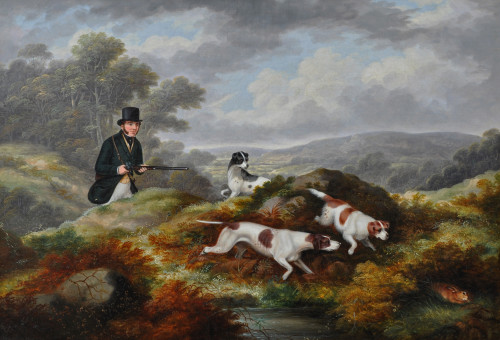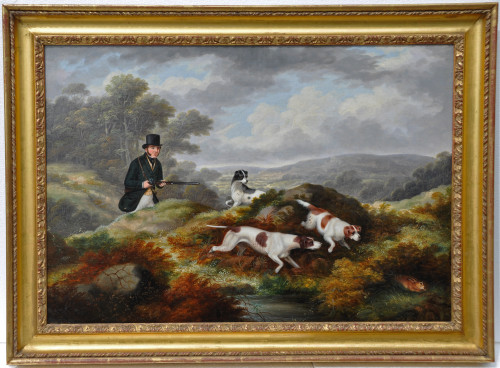A View of the Thames looking upstream from the Terrace of Somerset House
A View of the Thames looking upstream from the Terrace of Somerset House
Att. to THOMAS PRIEST
Op. circa 1750
English School
A View of the Thames looking upstream from the Terrace of Somerset House
Oil on canvas
43.2 x 97.6 cms
17 x 383//8 inches
Overall framed size 56 x 111 cms
22 x 435/8 ins
Provenance: U.S. private collection
With Knoedler and Co., New York
Ex Collection: Walter S M Burns, North Mimms Park, Hatfield
The English painters Samuel Scott, William James and William Marlow picked up on this style and there were several others of varying ability such as Samuel Wale, Francis Harding, Joseph Nicholls and Herbert Pugh who were commissioned to paint views of a city rapidly expanding in size, influence and wealth. There is evidence though that Scott was already painting topographical views of London before the arrival of Canaletto with a drawing of Westminster Abbey and Hall from the River in the British Museum confidently dated to 1738 providing the evidence for this. There is also speculation that some of these painters utilised a camera lucida or other such optical devices which would explain some of the occasional distorted buildings, even apparent in an artist of Scott's ability.
Britain is fortunate in that it has an unrivalled record of topographical record compared to Europe. On the continent, major towns or cities were occasionally depicted as were important castles or palaces such as Versailles for example but in Britain there is an abundance of engravings and paintings depicting country houses, churches, villages, towns, cities and parts of them.
The astonishing wealth of records, "There is simply nothing like this in the rest of Europe, not even after 1800, and no other country in the world has today such an efficient system of rate-supported County Record or Archive Offices which take into their care the paper history of the county" (John Harris in 'Prospects of Town and Park' - National Art-Collections Fund Exhibition, Colnaghi 1988) There were large numbers of antiquarians and there was enormous interest in recording the history and topographical views in written and painted records. One can only surmise why this is the case, perhaps it is a deep-rooted consequence of the Domesday Book, but whatever the reason, there is an abundance of painted views and aspects of houses and urban areas.
Therefore it is rather ironic that the genre of topographical painting had really been introduced to England from Northern Europe where artists in the Netherlands had an established tradition. There are few surviving illustrations from the Tudor period although some artists from the Low Countries such as Hoefnagel in 1568 and van der Wyngaerde in 1559 did work in England. It was following the Restoration and the coronation of Charles II in 1660, marking the end of the governance of Parliament, and then, particularly after the accession of William of Orange in 1689, that the influence of art and architecture from Holland became marked in England.
The Earl of Arundel had returned from a mission to Vienna in 1636 with the Prague-born artist Wenceslaus Hollar who remained here until 1644. He returned again in 1652, remaining until his death in 1677 and although most of his work survives in engraved form, he was a significant influence on English landscape painting. He managed to impart an English sensibility to the Northern European style and this can be discerned in "A View of the Thames below Wesminster Pier" now in the Barber Institute.
By the late part of the 17th century and into the 18th, artists such as Jacob Knyff, Jan Griffier, Thomas Wyck, Hendrik Danckerts and Johannes Vorsterman followed a little later by Pieter Tillemans, Jan Siberechts, Leonard Knyff and Pieter Andreas Rysbrack the Younger were in residence here and were being commissioned to paint panoramic views of country houses and estates as well as towns and views of London from the Thames. Printed guides started to appear in the early 1700s with engravings county by county and the number of architectural books published in Britain between 1715 and 1800 exceeded that of the whole of Europe in the same period. There was a seemingly almost insatiable desire to have a record of man's achievements in developing the built environment and bringing order to nature.
In the 1740s topographical art in Britain received an invigorating influence from Italy, a consequence of the increasing popularity of the Grand Tour. The most famous of the Italian artists were Canaletto and Antonio Joli and the former's paintings had started to reach these shores in the late 1720s. Canaletto himself arrived in London in the summer of 1746. George Vertue, in his Notebooks in the Walpole Society writes: "…came to London from Venice the Famous Painter of Views Cannalletti …the Multitude of his works done abroad for English noblemen and Gentlemen has procurd him great reputation and his great merit and excellence in that way, he is much esteemed…" His "Whitehall and the Privy Garden from Richmond House" and "The Thames and the City of London from Richmond House", both magnificent paintings and now at Goodwood, had a marked effect.
Canaletto's paintings of "A View of Westminster from the Terrace of Somerset House" and "The Thames from Somerset House Terrace towards the City" were both engraved in 1751 and there can be no doubt that these engravings acted as a further stimulus to contemporary and later artists to depict similar compositions.
The English painters Samuel Scott, William James and William Marlow picked up on this style and there were several others of varying ability such as Samuel Wale, Francis Harding, Joseph Nicholls and Herbert Pugh who were commissioned to paint views of a city rapidly expanding in size, influence and wealth. There is evidence though that Scott was already painting topographical views of London before the arrival of Canaletto with a drawing of Westminster Abbey and Hall from the River in the British Museum confidently dated to 1738 providing the evidence for this. There is also speculation that some of these painters utilised a camera lucida or other such optical devices which would explain some of the occasional distorted buildings, even apparent in an artist of Scott's ability.
Thomas Priest's largest body of surviving autograph works is a series of etchings along the Thames which were included in a small volume which are of great topographical interest. Several of these he also reproduced in oils together with other works which closely resemble the paintings of the popular Samuel Scott and William James. These works based on the aforementioned painters were not as tight in their technique with looser definition in the buildings depicted. He employed a pinkish tinge in many of his paintings.
London has three paintings by him in public collections. "Chelsea from the River" is in the Chelsea Library, "The Thames at Battersea" is in the Wandsworth Museum and "The Red House, Battersea" is in the Government Art Collection.
SOMERSET HOUSE
The original Somerset House was built by Edward Seymour, Duke of Somerset (1506-1552), the Lord Protector of the boy king Edward VI. It is related that he had the Inns, as they were called, of the Bishops of Coventry, Lichfield, Chester, Worcester and Llandaff, as well as the old parish church of St Mary's, raised to the ground "without any recompense" so as to create a flat space to build his new palace. The architect employed for its design was John of Padua who was responsible for Longleat and who, under Henry VIII, held the post of "Devizer of His Majesty's Buildings". It was started in 1546 but as Somerset was in the Tower of London in October 1548, it is doubtful whether he ever lived in it.
Somerset had fallen victim to the intrigue and dangerous politics of Tudor England and after his beheading in 1552, was succeeded by John Dudley, Earl of Warwick, Duke of Northumberland as Protector. Somerset's palace reverted to the Crown and was used as a royal palace by Elizabeth I, James I's wife Anne of Denmark and the neglected wife of Charles II, Catherine of Braganza. Later it came to be a residence of dowager queens or temporary residences of foreign princes or ambassadors.
All these different residents made alterations both in and outside the main building. By 1706, there were extensive terraced gardens facing the Thames with stairs at each end. The gardens were laid out in the square and rather dull style of the time with avenues of trees and gravel paths. Alexander Pope wrote of them: "Grove nods to grove, each alley has its brother, And half the garden just reflects the other". Along the river there was a raised terrace and a heavy low wall which remained after a substantial part of the palace was demolished and then rebuilt in1776.
A few yards upstream from Somerset House was York Water Gate and Water Tower. The former, built in 1626, was all that remained after the demolition of York House by its owner, George Villiers, Duke of Buckingham a few years after the Restoration. The Gate originally led down to the river but since the building of the Embankment in the 1860s, it is now in the gardens off Villiers Street, 150 yards from the river. The Water Tower - at the end of what is now Villiers St. - was close by the Gate and constructed between 1690 and 1695 from wood and its purpose was supplying the Strand and its neighbourhood with water from the Thames. It was an octagonal structure, about seventy feet high and was illuminated within by small loopholes in its sides. It was certainly still standing in the 1780s. The York Buildings Waterworks Company building with its chimneys was adjacent, Samuel Pepys's house was just behind it and the Salt Office was in close proximity.
As one progressed further upstream, on the north side of the river one would see Banqueting House, Westminster House, Westminster Hall, the two towers of the Church of St John the Evangelist and then Westminster Bridge which had been completed on 25th October 1746.
Bibliography:
Dictionary of British Landscape Painters - M H Grant
British Landscape Painters of the 18th Century - Luke Hermann
Prospects of Town and Park - National Art-Collections Fund Exhibition, Colnaghi 1988
Old and New London Vols I & III - Edward Walford
1750
Oil on canvas
England
U.S. private collection
With Knoedler and Co., New York
Ex Collection: Walter S M Burns, North Mimms Park, Hatfield
RELATED ITEMS






















